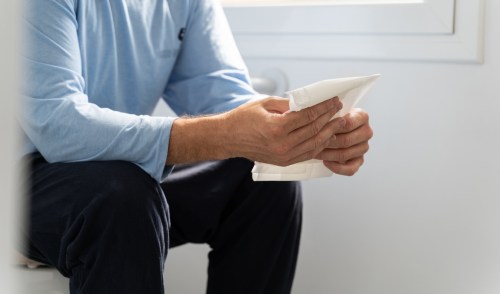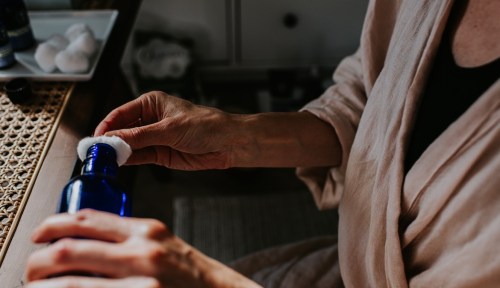Need To Get Things Moving? Here Are the 7 Best Acupressure Points for Constipation Relief
Pressure points for constipation can boost bowel movements. Here, discover effective acupressure techniques for relieving constipation.

Once upon a time, you may have never given a second thought to pooping every day. As we age, though, it’s common to become less and less regular. In fact, according to the National Institute on Aging, “Nearly everyone becomes constipated at one time or another, and older people are more likely than younger ones to experience this condition. In fact, about one-third of older adults have occasional symptoms of constipation.”
Experts in This Article
New York City-based acupuncturist and herbalist
licensed acupuncturist and chief of acupuncture at ORA Space
faculty member at the Institute of Classical Five Elements Acupuncture, an associate at Mother Nurture Wellness, and WTHN’s head of product and service innovation
licensed acupuncturist, traditional Chinese medicine expert, and co-founder of WTHN
Thankfully, constipation is typically treatable. Before reaching for a laxative, though, consider a more holistic approach with pressure points for constipation. Just as pressure points for sleep and foot reflexology exist, hitting the right spots can also support bowel health. Keep reading to find out where they are, and how you can take advantage.
But first, what causes constipation?
While constipation can be caused by physical issues like lack of hydration, a lack of movement, eating foods that cause constipationlike bananas, and a change in sleep patterns, co-founder of holistic health studio WTHN Shari Auth, DACM, LAc, explains that it can also be caused by emotional issues like anxiety. That’s why yoga moves like camel pose or stretches for constipation can sometimes help, as can other relaxation techniques like acupressure.
How can pressure points for constipation help?
Constipation is one of the worst feelings. Whether your experience means you can’t poop at all or you’re having incomplete poops, Elizabeth So, DACM, LAc, an acupuncturist and herbalist in New York City, says you can use pressure points for constipation to get things moving again.
“Acupressure can help with constipation by promoting movement in the bowel system to encourage elimination,” Dr. So says. “Sometimes our bodies simply need a bit of a push to get things moving. From a biomedical point of view, our intestines contract involuntarily to move food and waste through our digestive tract. If there is some element of blockage, the movement can slow or even come to a halt. Acupressure can provide manual stimulation locally as well as distal channel balancing to reinstitute proper flow.”
According to acupuncturistGabriel A. Sher, Lac, who is the chief of acupuncture and TCM development at New York City acupuncture studio ORA, the theory behind acupressure is that pressure points directly affect the flow of Qi, or vital energy. “Pressure points work by stimulating the point,which opens specific channels to stimulate a Qi response,” he explains. “In Chinese medicine, we believe stagnancy is what causes disease.”
Nicole Glathe, DAOM, LAc, Dipl OM, WTHN’s head of product and service innovation, explains that pressure points are located along nerve pathways, called meridians, through which energy, or Qi, flows. “Stimulating them sends signals to your brain that unlock healing naturally through the body’s own mechanism of action,” she says. “Practitioners of acupuncture insert fine needles into these points to achieve an effect, but by applying pressure to the points, you can rebalance the body’s energy flow, address specific ailments, and promote overall well-being at home.”
So, while you may not consider energy and poop to go hand-in-hand, they do. “Energetically speaking, [constipation is] a blockage,” says Dr. Auth. “Increased stress impairs the natural movement of the large intestines via the brain-gut axis, keeping us in our ‘fight or flight,’ or sympathetic nervous system. Acupressure can decrease stress and shift us into our ‘rest and digest’ or parasympathetic nervous system. When we shift into our parasympathetic nervous system, the blood goes to our GI tract and increases movement in our bowels and healthy elimination of stool.” This is why acupressure can be ideal self-help for constipation.
Who can use pressure points for constipation?
One of the biggest misconceptions about acupressure is that you have to be a trained acupuncturist to do it. “While it’s true that your acupuncturist will know more techniques and channel theory, there are many profoundly simple and effective ways in which anyone, trained or untrained, can use acupressure to relieve a variety of symptoms,” Dr. So says.
With that in mind, there are a few pressure points for constipation that you can stimulate at home.
The best pressure points for constipation
Before exploring the intersection of digestive health and acupressure, it helps to know how to properly stimulate pressure points for regularity. “Use your thumb to gradually apply increasing pressure on a point until you find the sweet spot where it’s just enough pressure to feel some resistance without discomfort or pain,” Dr. Auth says. “Then hold constant pressure and make a circular motion with your thumb, gently massaging the point.”
To make the most of these natural constipation remedies, Dr. Auth says to make sure you’re comfortable. “We believe that healing is best when it’s a multi-sensory journey, so whether that means lighting a candle or some aromatherapy, dimming the lights, or turning on some soothing music, that will surely get the acupressure mood going,” she says.
Ready to do some acupressure for constipation? Here are seven specific acupressure techniques for bowel health.
1. Large Intestine 4
Dr. Auth says that the tighter and sorer this spot is, the more benefit it can give you. “Gently pinch the web between the index finger and thumb of your left hand with your right thumb and right index finger. Rotate the right thumb in a circular motion applying just enough pressure to feel resistance without pain,” says Dr. Auth. “As the resistance releases, gradually apply more pressure. Breathe slow and deep as you do this and then switch sides. Keep rubbing until you feel a release in the area for at least 10 deep breaths.
2. Ren 6
According to Sher, Ren 6 (aka Qihai) is a key pressure point for constipation relief. “Known as the sea of Qi, Ren 6 is located two finger breadths below the belly button,” he shares.
3. Ren 12
To find this point on the abdomen, Dr. So says to look in the mirror. “Draw an imaginary line from the bottom of your sternum, the part of your chest where your ribs start to curve away from each other in an upside-down V shape, and your belly button,” says Dr. So. “Right at the midpoint of the line drawn from between these two landmarks is a point called Ren 12. You can begin your acupressure by pressing firmly into this point with your thumb or middle finger. Oftentimes, it will feel full or tender to the touch. Hold for 30 seconds and then knead in small clockwise circles for another 60 seconds.”
4. Stomach 25
Dr. So says this point is located bilaterally on either side of your belly button, about two or three inches out from the centerline. “The distance from your belly button will be slightly different on people of different sizes,” she says. Ideally, it is best to find the highest point of your [abdominal] muscles. If you are at the highest point of this band of muscle and are in line with your belly button, you’re in the right spot! Start with the point on the right side of your abdomen, pressing in firmly for 30 seconds and then kneading in small, clockwise circles for 60 seconds. Repeat the same technique on the left side point.”
5 and 6. Stomach 36 and 37
“Stomach 36 is a big point, so best to use the first two fingers to dig deep,” says Dr. Auth. She says it’s located at the top of the shin about a palms length below the knee. “Gradually apply pressure using a circular motion, don’t be afraid to apply deep pressure here. You should not experience any pain but should feel some sensation. As the resistance releases gradually apply more pressure. Breathe slow and deep as you do this and then switch sides. Keep rubbing until you feel a release in the area. Move down the shin another palm width and do the same with Stomach 37.”
7. SJ 6
Short for San Jiao 6, SJ 6 is another beneficial pressure point for constipation, says Dr. Glathe. “It’s found on the top of the forearm, in between the two bones, 3 finger widths below the wrist,” she reveals.
Try the “four doors approach” to relieving constipation
Now that you know seven of the most effective constipation relief points, you may be wondering which to use first or if they should all be used in unison. Sher suggests using the “four doors approach” to relieve constipation.
“I love using the four doors to help open up the channel and get the digestive Qi flowing,” he says. “This includes three points: Stomach 25, Ren 6, and Ren 12. These points help stimulate the movement of digestive Qi, strengthen digestion, and harmonize the intestines. I [also] always recommend adding Stomach 36. This point is one of the most effective points to help strengthen digestion and general longevity in life.”
To cycle through the four doors, “stimulate the pressure points in a clockwise motion starting from Stomach 25 on your right side, moving up to Ren 12, continuing in a circular motion to Stomach 25 on the left, followed by Ren 6,” Sher says. “This is the same pattern as our normal intestinal movement. The acupressure mirrors the direction of the bowels, going from the ascending colon to the transverse colon, and then to the descending colon.”
While these four pressure points are highly effective on their own for boosting bowel function, Dr. Glathe says that cycling through all of the pressure points for constipation can prove beneficial. “Take five or more deep breaths while gently massaging each of the points with a fingertip,” she says. “Cycle through three times, two to three times a day until digestive relief is achieved.”
After working your way through your routine for holistic constipation relief, Dr. So says to “end by placing both hands on your low abdomen just below your belly button. Place your right hand so that it is touching your abdomen and your left hand so that it is stacked on top of your right. Take five to 10 deep abdominal breaths, in through the nose and out through the mouth.”
While your hands are on your belly, Dr. Glathe says that a gentle abdominal massage can further assist in your constipation journey. “In addition to massaging the above acupoints a few times per day or during discomfort, abdominal massage can be added,” she says. “Using light pressure, start in the lower right quadrant of your abdomen near your hip bone, working your way up clockwise past your belly button to below the right ribcage, then over to the left side, then down to the left lower quadrant, and back across the bottom of your belly.” For best results, she says to repeat this sequence five to eight times. “This follows the pathway of your large intestine and can help to gently stimulate a bowel movement or release of bloating.”
The benefits of pressure points for constipation—and their limits
While many laxatives exist, pressure points for regularity offer a more holistic approach to constipation relief.
As effective as acupressure is, it doesn’t operate in the same way as traditional laxatives. “Unlike taking a laxative or something external, using acupressure taps into the body’s own mechanisms of action, which creates a gentle response that is most effective over time,” says Dr. Glathe. “It is recommended to apply pressure to the points two to three times a day in the beginning, then reduce the frequency as bowel movements become more regular.”
Overall, Dr. Glathe says acupressure is considered generally safe for most people. “It is advised to discontinue or reduce pressure if you become sore over the points or experience any uncomfortable sensations,” she adds.
But as useful as pressure points for constipation can be, they’re not always a one-stop solution for relief. If you find that you haven’t pooped in a week, it’s important to seek medical attention to address the issue and to prevent it from becoming more severe.
Sign Up for Our Daily Newsletter
Get all the latest in wellness, trends, food, fitness, beauty, and more delivered right to your inbox.
Got it, you've been added to our email list.










